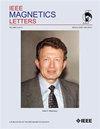Preparation of Temperature-Sensitive Rare-Earth–Iron Alloy Fine Particles Using Mechanical Alloying and Sintering
IF 1.1
4区 物理与天体物理
Q4 ENGINEERING, ELECTRICAL & ELECTRONIC
引用次数: 0
Abstract
Fine magnetic particles with high saturation magnetization and a large temperature-sensitive magnetization in the temperature range 300–400 K were prepared for use in temperature-sensitive magnetorheological fluids. Two methods, namely high-energy ball milling (HEBM) and sintering followed by HEBM to produce mechanochemical alloys, were used to produce R 2 Fe 17 component particles. The prepared particles were submicrometer- to micrometer-sized and contained rare-earth–iron alloys and α-Fe phases. Among the prepared particles, Sm 2 Fe 17 composition powder exhibited the highest temperature sensitivity of −0.02 A m 2 kg −1 K −1 at 400 K. Furthermore, powders with varying Fe and Sm composition ratios were prepared by sintering and ball milling. The powder prepared from the initial SmFe 5 composition exhibited the highest temperature sensitivity of −0.32 A m 2 kg −1 K −1 at 400 K and saturation magnetization was ∼90 A m 2 kg −1 . The powder was composed of SmFe 5 and Sm 2 Fe 17 in crystalline, α-Fe phase, and amorphous phase, as revealed by X-ray diffraction analysis and a scanning electron microscope, as well as high-resolution transmission electron microscopy with selected area electron diffraction.用机械合金化和烧结法制备对温度敏感的稀土-铁合金细颗粒
制备了在300–400 K温度范围内具有高饱和磁化强度和大温敏磁化强度的精细磁性颗粒,用于温敏磁流变流体。使用两种方法,即高能球磨(HEBM)和烧结,然后用HEBM生产机械化学合金,来生产R2Fe17组分颗粒。制备的颗粒尺寸为亚微米至微米,含有稀土-铁合金和α-Fe相。在制备的颗粒中,Sm2Fe17组成的粉末在400 K下表现出最高的温度敏感性,为−0.02 A m2 kg−1 K−1。此外,通过烧结和球磨制备了不同Fe和Sm组成比的粉末。由初始SmFe5成分制备的粉末在400 K下表现出最高的温度敏感性,为−0.32 A m2 kg−1 K−1,饱和磁化强度为~90 A m2 kg-1。X射线衍射分析和扫描电子显微镜以及选区电子衍射的高分辨率透射电子显微镜显示,该粉末由结晶相、α-Fe相和非晶相的SmFe5和Sm2Fe17组成。
本文章由计算机程序翻译,如有差异,请以英文原文为准。
求助全文
约1分钟内获得全文
求助全文
来源期刊

IEEE Magnetics Letters
PHYSICS, APPLIED-
CiteScore
2.40
自引率
0.00%
发文量
37
期刊介绍:
IEEE Magnetics Letters is a peer-reviewed, archival journal covering the physics and engineering of magnetism, magnetic materials, applied magnetics, design and application of magnetic devices, bio-magnetics, magneto-electronics, and spin electronics. IEEE Magnetics Letters publishes short, scholarly articles of substantial current interest.
IEEE Magnetics Letters is a hybrid Open Access (OA) journal. For a fee, authors have the option making their articles freely available to all, including non-subscribers. OA articles are identified as Open Access.
 求助内容:
求助内容: 应助结果提醒方式:
应助结果提醒方式:


